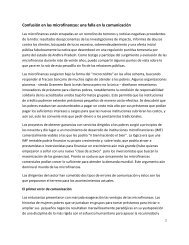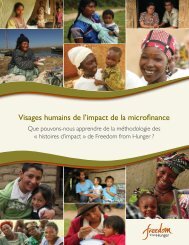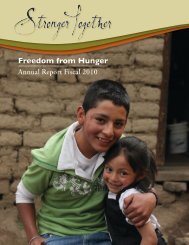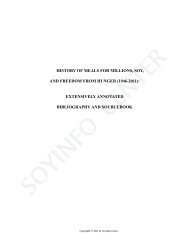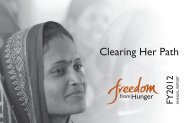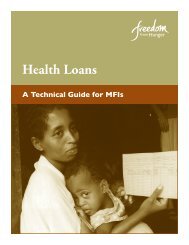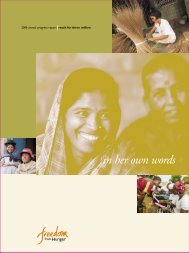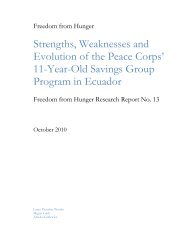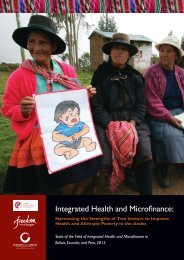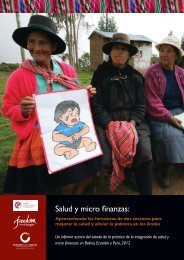Voices from the Frontlines: - Freedom from Hunger
Voices from the Frontlines: - Freedom from Hunger
Voices from the Frontlines: - Freedom from Hunger
You also want an ePaper? Increase the reach of your titles
YUMPU automatically turns print PDFs into web optimized ePapers that Google loves.
schedule.” Ano<strong>the</strong>r shared that she spends a lot of time doing things that don’t officially<br />
correspond to her functions, such as taking clients to health centers where CRECER has<br />
agreements. Also, she spends a lot of time outside of normal work hours following up with<br />
clients who haven’t paid and are in default. Ano<strong>the</strong>r shared that because her group members<br />
trust her so much, she must serve in many roles o<strong>the</strong>r than credit officer. Many times she plays<br />
<strong>the</strong> role of psychologist, conciliator, judge or “heart doctor.” She orients <strong>the</strong>m in matters of<br />
services and family matters. “This is perhaps what <strong>the</strong> women like.” One credit officer at ano<strong>the</strong>r<br />
organization indicated that she spends “…ten percent of <strong>the</strong> entire day. I won’t tell my members that I<br />
don’t have time for <strong>the</strong>m.” However, most credit officers at that same organization felt that <strong>the</strong>y<br />
don’t have time outside of <strong>the</strong> work day to do “o<strong>the</strong>r things.” This was reflected in <strong>the</strong> o<strong>the</strong>r<br />
three organizations as well. For example, one credit officer said, “We know what we have to do and<br />
we don’t dedicate a lot of time to o<strong>the</strong>r stuff.” How credit officers responded to this question likely has<br />
a lot to do with how <strong>the</strong>y interpreted <strong>the</strong> question and how <strong>the</strong>y interpret <strong>the</strong>ir “job description”<br />
and “normal duties.”<br />
ANALYSIS<br />
In review of <strong>the</strong> findings <strong>from</strong> this study, we can draw some rough conclusions and build new<br />
research questions and <strong>the</strong>ories about <strong>the</strong> crucial role that credit officers play in organizational and<br />
in client success.<br />
One key question raised is about external validity. How much can we generalize <strong>from</strong> <strong>the</strong>se results?<br />
Are <strong>the</strong> results <strong>from</strong> <strong>the</strong> staff and clients of <strong>the</strong>se five institutions likely to be found for o<strong>the</strong>r<br />
financial service providers in o<strong>the</strong>r geographic areas? Would we find similar findings among<br />
institutions that do not base <strong>the</strong>ir service on group lending or when <strong>the</strong> only interaction with <strong>the</strong><br />
client might be through a technology platform or through a brief interaction at a bank-teller<br />
window? We noted in our Methods section that our sampling was quite opportunistic but that we<br />
also made efforts to ensure representation when we were unable to interview all of <strong>the</strong> credit<br />
officers at any given partner. While a random sample of credit officers would have streng<strong>the</strong>ned our<br />
findings, this research was exploratory and we feel <strong>the</strong> findings provide us with fodder for future<br />
research. Fur<strong>the</strong>rmore, <strong>the</strong> research highlighted at <strong>the</strong> beginning of this report by Schoar 9 suggests<br />
that even for individual lending organizations, relationships and “touch points” with a bank’s staff<br />
matters for client satisfaction and client “empowerment.” <strong>Freedom</strong> <strong>from</strong> <strong>Hunger</strong> staff reflecting on<br />
this research felt we would find similar results across our geographic programs (Asia, Africa, Latin<br />
America) as well as across product-types that <strong>the</strong> organizations are providing. Organizations<br />
providing ei<strong>the</strong>r or both group-based lending and individual-lending products would see similar<br />
results in terms of <strong>the</strong> importance of <strong>the</strong> relationship with <strong>the</strong> credit officer.<br />
Ano<strong>the</strong>r <strong>the</strong>ory to be tested is related to social performance of <strong>the</strong> MFI. In this case, we have five<br />
institutions that have been fairly active in building <strong>the</strong>ir social performance. They try to link <strong>the</strong>ir<br />
9 See footnote 3.<br />
<strong>Voices</strong> <strong>from</strong> <strong>the</strong> <strong>Frontlines</strong> 23



